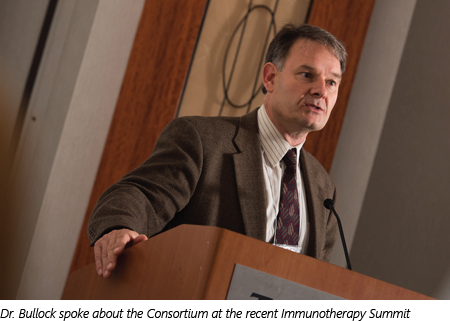
The Foundation’s multi-site consortium to streamline efforts and accelerate progress in using FUS to increase the body’s anti-tumor immune response has launched its first major project. Researchers at seven institutions will investigate the effects of different FUS modalities on the immune system, each using the same animal model of glioblastoma multiforme (GBM), an aggressive and difficult to treat brain tumor.
“Focused ultrasound is such a versatile tool that it can be difficult to decide which mechanism of action to use in exciting new applications like immunotherapy,” says Kelsie Timbie, PhD, the Foundation’s Scientific Programs Manager. “The consortium project was born out of this need, and we anticipate that it will provide a solid stepping stone to clinical translation.”
The Foundation, and the research community as a whole, recognized the need to compare these modalities using consistent metrics to determine how each can harness the incredible power of the immune system in this notoriously difficult to treat cancer.
After the consortium completes this work, the modality – or modalities – that produce the most promising results will be assessed in larger translational studies and/or in combination with specific immunotherapeutics.
Cancer immunotherapies are agents that harness the power of the immune system to fight cancer by enabling it to specifically seek out, identify, and destroy cancer cells. Focused ultrasound can enhance this immune response in several ways, including:
- Stimulating tumor cells to release signals that activate the immune system.
- Increasing immune cell access to the tumor.
- Helping immunotherapy drugs or biologicals reach their tumor targets.
These research sites and investigators have joined the GBM consortium:
- Brigham and Women’s Hospital/Dana Farber – Nathan McDannold, PhD, and David Reardon, MD
- Georgia Institute of Technology – Costas Arvanitis, PhD
- National Institutes of Health Intramural Research Program– Joseph Frank, MD (Advising)
- Sunnybrook Research Institute – Kullervo Hynynen, PhD
- University of Maryland – Graeme Woodworth, MD, and Victor Frenkel, PhD
- University of Michigan – Zhen Xu, PhD, and Charles Cain, PhD
- University of Virginia – Rich Price, PhD, and Tim Bullock, PhD
Project Overview
Focused ultrasound can be used in a variety of ways with different mechanisms of action. These different FUS modalities include: thermal ablation, hyperthermia, histotripsy, pulsed/low intensity focused ultrasound, and microbubble-enhanced mechanical ablation. Each site will investigate and determine the most promising parameters for their modality, including percentage of tumor volume to be treated, pressure, frequency, duty cycle, and microbubble dose (if applicable). The sites will compare two groups of mice with GBM—one that is treated and one that is not treated (to be used as a control). Imaging studies will measure tumor growth, and flow cytometry and immunohistochemistry will analyze the immune response to the tumor as well as changes in tumor cell death.
The six month project will combine data from all of the sites to produce a joint publication.
FUS and Immunotherapy Timeline
- October 2016 – A second international workshop, the Focused Ultrasound and Immunotherapy Summit, was held in Alexandria, Virginia.
- August 2016 – A key session at our 5th International Symposium on Focused Ultrasound highlighted recent advances in focused ultrasound and cancer immunotherapy.
- April 2016 – We produced a high-level overview of cancer immunotherapy with focused ultrasound, including a comprehensive list of studies, see Cancer Immunotherapy State of the Field report.
- November 2015 – Our workshop on the use of FUS for the treatment of GBM helped refine the gaps in knowledge that led to the GBM consortium project.
- June 2015 – Our Cancer Immunotherapy Focus Feature introduced the science, scientists, and partnerships that are pushing this emerging field into the forefront.
- March 2015 – We held an Immunotherapy 101 webinar presented by UVA Immunologist Tim Bullock, PhD.
- February 2015- Our first cancer immunotherapy workshop was held in New York, see the 2011 Immunotherapy Workshop Summary.
